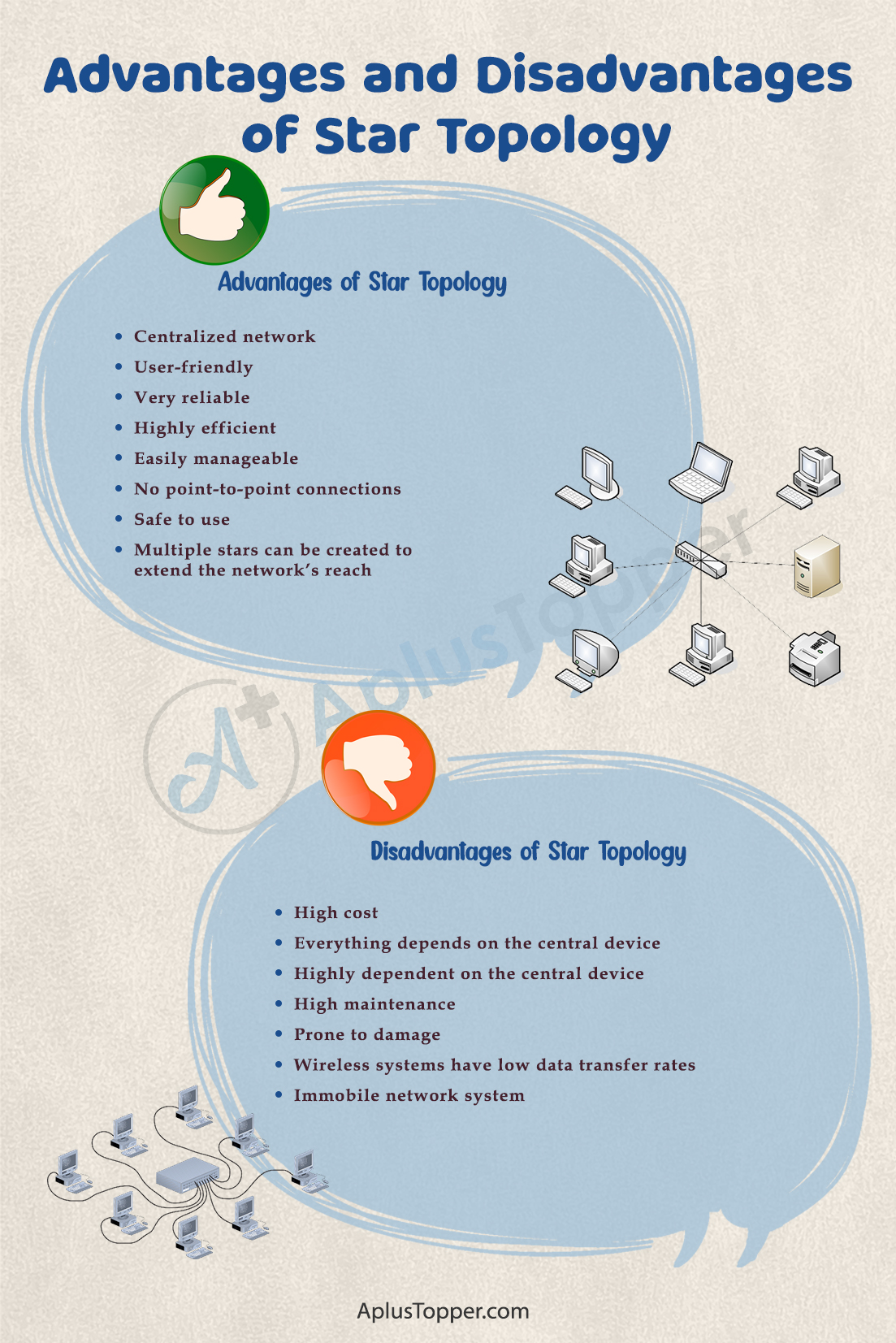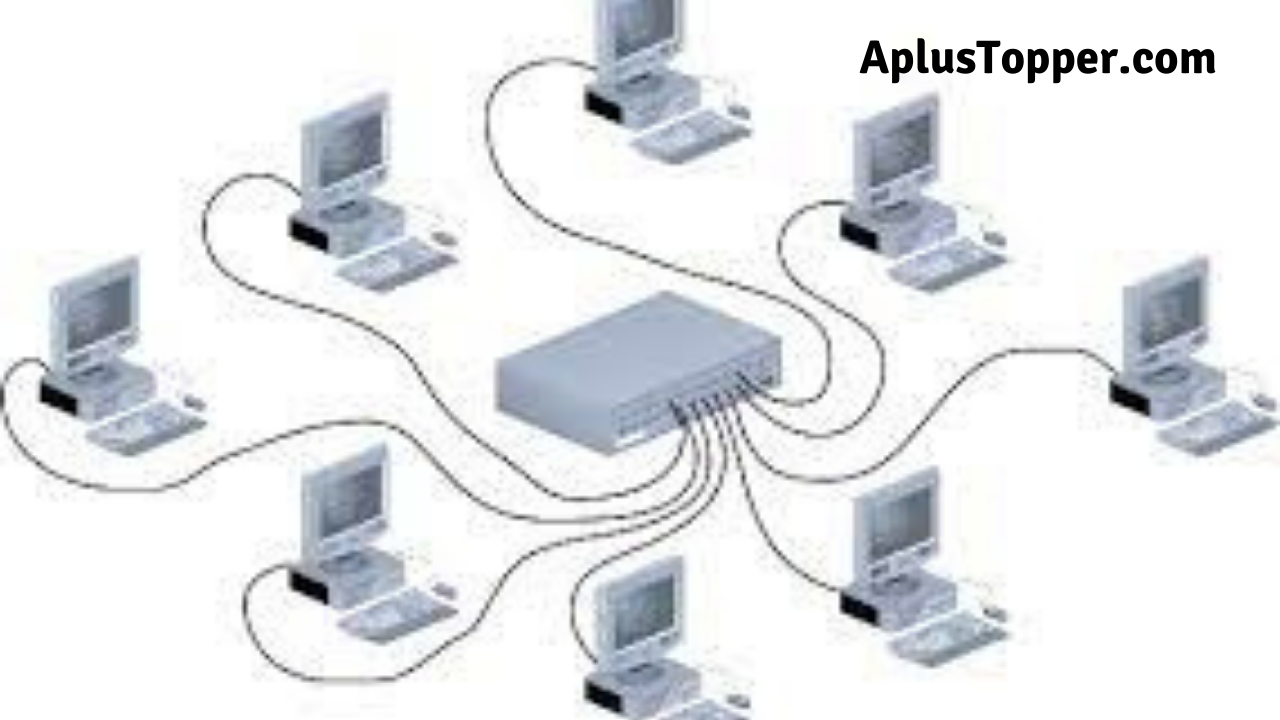Star Topology Advantages and Disadvantages | What is Star Topology? Advantages and Disadvantages of Star Network Topology
Star Topology Advantages and Disadvantages: Star topology is a network topology form where each piece of the network is attached to a central node called a hub or switch. In this network, every host is connected to a central hub. In the simplest form, one central hub acts as a channel to transmit messages. Star network is one of the most popular computer network topologies.
The attachment of these network pieces to the central component is visually represented in a form similar to a star. It is also known as a star network.
Students can also find more Advantages and Disadvantages articles on events, persons, sports, technology, and many more.
What is Star Topology? Advantages and Disadvantages of Star Topology 2022
Star topology is a popular and standard network setup, alternatively referred to as a star network. Every node connects to a central network device in this configuration, like a hub, switch, or computer. The central network device acts as a server, and the peripheral devices act as clients. In a star topology setup, either a coaxial or RJ-45 network cable is used, depending on the type of network card installed in each computer.
Star topologies can be either active or passive networks, depending on the following:
- If the central node performs data amplification or regeneration or such processes.
- If the network actively controls data transit
- If the network requires electrical power sources.
Star topology can also be implemented with Ethernet, cabled structures, wireless routers or other components. In many systems, the central hub is the server, and the additional nodes are clients.
- Advantages of Star Topology
- Disadvantages of Star Topology
- Comparison Table for Advantages & Disadvantages of Star Topology
- FAQs on Pros & Cons of Star Topology

Advantages of Star Topology
The advantages of using star topology are listed below:
- Centralized network: Centralized management helps monitor the network by using the central computer, hub, or switch.
- User-friendly: In star topology, new nodes can be added easily without affecting the rest of the network. Similarly, components can also be removed easily. Hence it is easy to add another computer to the network, and it also becomes easier to replace a malfunctioning unit to maintain your productivity levels.
- Very reliable: If one cable or device fails, then all the others will still work. So, the failure of one node or link doesn’t affect the rest of the network.
- Highly efficient: As in star topology, each device connects to the central core with its cable, the chances of data collisions are relatively minimal. This also means the performance levels of this system are exceptionally high compared to other network designs.
- Easily manageable: Easy fault detection because the link is often easily identified. At the same time, it’s easy to detect the failure and troubleshoot it.
- No point-to-point connections: A star topology system is useful for networks of practically any size. There are zero risks of signal reflection within the network, which creates a secure way to transmit data packets with unicast communication and point-based communication connections.
- Safe to use: When a star topology experiences a cut cable or a NIC failure, it will only affect one node. Then the only way to take down all of the devices at once is to disable the central core. Since the central device is not easily available to everyone, it is a safe and secure network that businesses of any size can use to support their needs.
- Multiple stars can be created to extend the network’s reach: When using star topology, you can extend the length of the network by configuring multiple stars with a central core device in the middle as a server. However, the network must have enough power to support all activities for this approach to be functional.

Disadvantages of Star Topology
The list of the disadvantages for star topology are given below:
- High cost: Implementing a switch or router may have a higher price, especially when using a switch or router as the central network device.
- Everything depends on the central device: The central network device determines the performance and number of nodes the network can handle.
- Highly dependent on the central device: If the hub goes down, everything goes down as none of the devices can work without a hub. The drawback is if the central device fails, the whole network goes down.
- High maintenance: Hub requires more resources and regular maintenance because it’s the central system of the star.
- Prone to damage: The cables or wires used in a star topology network create more potential damage exposure. It needs to go behind walls, under floors, and through other obstacles to reach the intended workstations or peripherals. Also, if the LAN requires installation work on the exterior of the building, it can become susceptible to changing weather conditions or wildlife impacts.
- Wireless systems have low data transfer rates: If you need a network to manage heavy load, then a wired star topology system works better than a wireless one. A wireless LAN (WLAN) moves much slower; hence the risk of a bottleneck rises.
- Immobile network system: Although wireless star topology systems are available today, most still depend on wired connections. That means the fixed length of the cable restricts the movements of individual workers. This issue can reduce productivity levels dramatically over time because one gets bound to sit at a specific distance from the central hub.
Star Topology Advantages And Disadvantages In Tabular Form
| Advantages | Disadvantages |
|---|---|
| 1. Easy to add new devices | 1. Dependent on the central hub |
| 2. Fault-tolerant, as a failure in one device won’t affect the rest of the network | 2. High initial cost due to the hub |
| 3. Easy to troubleshoot and isolate problems | 3. The hub can become a bottleneck if too many devices are connected |
| 4. Centralized control makes it easier to manage | 4. Requires more cable than other topologies |
| 5. Supports a variety of media types | 5. If the hub fails, the entire network goes down |
| 6. Easy to install and configure | 6. Limited scalability |
| 7. Security can be enhanced by using a managed hub | 7. Performance may degrade as more devices are added |
| 8. Better performance than bus topology | 8. Requires more maintenance |
| 9. Provides a high level of flexibility | 9. Not suitable for large networks |
| 10. Ideal for small to medium-sized networks | 10. Network performance may be affected by the distance between devices and the hub |
Comparison Table for Advantages & Disadvantages of Star Topology
| Advantages | Disadvantages |
| High speed | High maintenance |
| Highly scalable network | High dependency on the central device |
| Highly efficient | Expensive |
| Centralized network management | Requires additional equipment |
| Safe to use | Immobile systems |
| No point-to-point connections | Wires or cables used in the network get damaged easily |
| Highly reliable | Wireless star topology systems have low data transfer rates |

The star topology system works well for Local Area Networks (LAN) when multiple connection points are necessary for a network. And as discussed earlier, the central hub might be expensive to install, but the data packet movement is typically faster because it is self-contained.
Every business or project has its own needs to meet. We hope the star topology advantages and disadvantages discussed in this article will help you choose the right network for yourself.
FAQ’s on Pros & Cons of Star Topology
Question 1.
What is the use of star topology?
Answer:
Star topology is used to ease the possibilities of network failure by connecting all of the systems to a central device or node. This central hub again sends all transmissions received from any peripheral node to all other peripheral nodes on the network, sometimes including the originating node.
Question 2.
What are the examples of a star topology?
Answer:
Star network topologies are commonly used in home networks, where the central connection point may be a router, switch, or network hub. Unshielded Twisted Pair (UTP) Ethernet cabling is generally used to connect devices to the hub, though coaxial cable or optical fiber.
Question 3.
What are the other types of topologies besides star topology?
Answer:
The other types of topologies besides star topology are listed below:
- Ring Topology
- Bus Topology
- Tree Topology
- Mesh Topology
- Hybrid Topology
Question 4.
How does a star topology network work?
Answer:
In star topology networks, all nodes indirectly connect with each other through switches. The switch acts as the central point through which all communications are passed. Large networks using a star topology are usually controlled by one or more servers. Hence, the client-server model usually uses a star topology.
The post Star Topology Advantages and Disadvantages | What is Star Topology? Advantages and Disadvantages of Star Network Topology appeared first on A Plus Topper.
from A Plus Topper
via Learning Made Simple 360
*Note that these contents are Autoblogged from A Plus Topper and cannot be edited.
Join the conversation